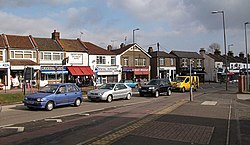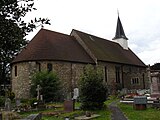Hadleigh, Essex
| Hadleigh | |
| Essex | |
|---|---|
 Hadleigh Town Centre | |
| Location | |
| Grid reference: | TQ810870 |
| Location: | 51°33’13"N, 0°36’34"E |
| Data | |
| Population: | 18,300 |
| Post town: | Benfleet |
| Postcode: | SS7 |
| Dialling code: | 01702 |
| Local Government | |
| Council: | Castle Point |
| Parliamentary constituency: |
Castle Point |
Hadleigh is a small town in south-eastern Essex, on the A13 between Benfleet and Leigh-on-Sea with a population of about 18,300.[1]
History
Hadleigh is known for its castle, and the country park that surrounds it. Most of the facing stones were stripped from the castle in the 16th century - the only bits still visible today being high inside the surviving towers and a small section on the 'gate house' - so most of what remains today is actually the rubble infill that was packed between the outer facing stones. Despite this the skeletal remains are pleasing to the eye and have been considered a romantic ruin for a few hundred years. John Constable painted Hadleigh Castle in 1829. The painting now belongs to the Yale Center for British Art, and is on permanent display in their museum on the Yale campus.[2] Set at the top of a hill overlooking the Thames Estuary, the Canary Wharf development to the west can be seen when visibility is adequate.
Another building of note is St. James the Less Church which was believed to be Norman but is now known to be Saxon because of its general dimensions, window alignments, Saxon Romanesque arches, pagan Saxon 'pudding stone' inclusions and the pagan Saxon 'fairy wheel' motif carved into the wall by the north door. The church remains picturesque despite the fact that it stands in the central reservation of the A13 road.
Hadleigh Farm (including the area around the castle) is a host venue for the London 2012 Olympic mountain biking events.
Salvation Army Farm Colony
- Main article: Hadleigh Farm
The colony was established in Hadleigh in 1891 by General Booth. He believed every human being should have food and shelter and published a plan to rescue the destitute from the squalor of London. His vision was that the poor would be given board and lodgings in a City Colony in exchange for a day’s work. They could then move to a Farm Colony where they would be trained to work the land and run their own smallholdings. Then finally they could progress to Overseas Colonies, running smallholdings abroad.
The trial City Colony was set up in Whitechapel in 1889 and two years later Booth put down a deposit on land in Hadleigh for his Farm Colony. Starting with 800 acres of land, later expanding to 3,200 acres, the farm was home to 200 colonists by the end of its first year.
Existing farm buildings were renovated and new dormitories, a bathhouse, laundry, reading room, hospital and religious meeting house were built. As well as farming and market gardening, colonists were taught brickmaking, pottery and construction skills.
Today the colony operates an employment training centre for people who have special training needs, and accepts referrals from Social Services and the Employment Service. The aim is to create a realistic working environment, with the intention of helping clients gain the skills necessary for work elsewhere. Employment at the training centre – reminiscent of the colony’s origins - includes horticulture, carpentry, catering, office skills and estate management.
Pictures
Outside links
| ("Wikimedia Commons" has material about Hadleigh, Essex) |



